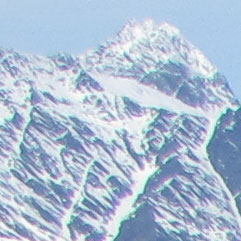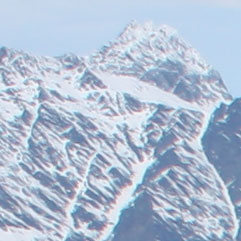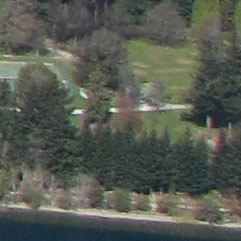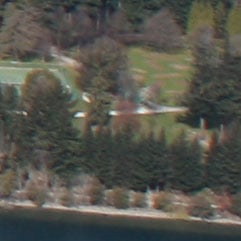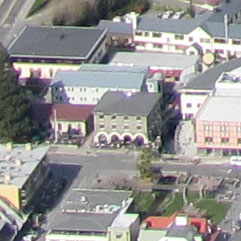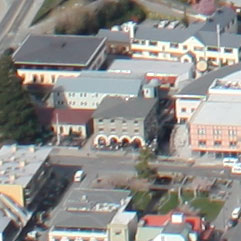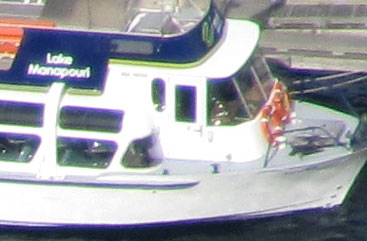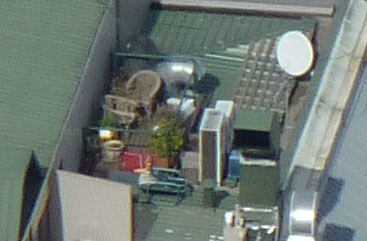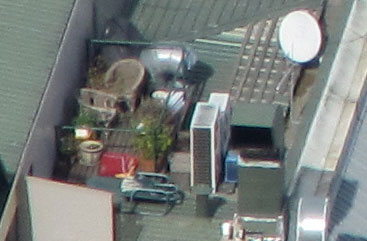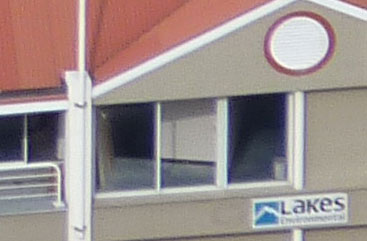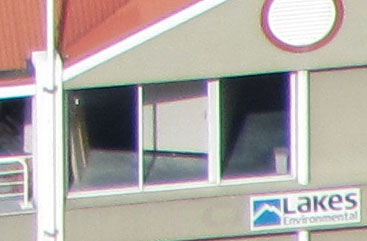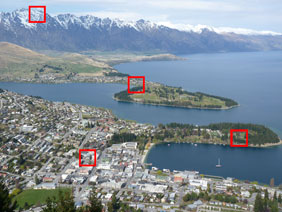Panasonic Lumix DMC-FZ38 / FZ35
-
-
Written by Gordon Laing
Panasonic Lumix FZ38 / FZ35 vs Canon PowerShot SX20 IS vs EOS 450D / XSi Real-life resolution
|
| ||||||||||
|
Panasonic Lumix DMC-FZ38 / FZ35: Diffraction issues
|
In our tests, the Panasonic FZ38 / FZ35 often selected smaller apertures than the Canon SX20 IS when faced with the same scene in its Program mode, due to a reluctance to use shutter speeds faster than 1/500 unless in extreme circumstances. For example, in the first shot at the top of this page, the Panasonic selected f5.6, while the Canon selected f4. This may not sound like a significant difference – indeed it’s only one stop in exposure terms – but optically it can have a noticeable impact. As the aperture reduces (using bigger f-numbers), an optical effect known as diffraction comes into play, reducing the sharpness of the image. Indeed at the minimum aperture of f8 on these super-zooms, it can significantly impact the quality. To illustrate the impact of diffraction at different aperture settings, we shot the same scene at f4, f5.6 and f8, and have cropped the same area at 100% below. It’s immediately clear the f4 version looks best of all, with f5.6 looking a little softer and the f8 sample looking much softer. As mentioned above, the FZ38 / FZ35 had a tendency to select f5.6 under bright conditions in its Auto / Program modes, when it could alternatively have gone for f4 and a faster shutter speed instead. To be fair, this is a better situation than the earlier FZ28 and FZ18 which actually opted for f8 under similar conditions, but it’s still not ideal. Luckily a simple prod of the joystick in Program can shift the aperture to a preferred value, or you could manually select it in Aperture Priority. The important thing is to keep an eye on the selected aperture when shooting in Program mode. If it’s at f5.6 or higher and you don’t need the maximum depth-of-field, then consider shifting it to a smaller value like f4 – as you can see below, the results will be sharper. Before wrapping up this page, scroll down a little further to see the FZ38 / FZ35’s RAW performance. |
Panasonic Lumix DMC-FZ38 / FZ35 diffraction at different apertures | ||||
 |
 |
 | ||
f4, 80 ISO (with Program shift) |
f5.6, 80 ISO (as metered in Program) |
f8, 80 ISO (with Program shift) | ||
Panasonic Lumix DMC-FZ38 / FZ35: JPEG versus RAW
|
We photographed the scene here in the Lumix FZ38 / FZ35’s RAW plus JPEG mode, allowing us to directly compare images created from exactly the same data. Strangely the Silkypix Developer Studio supplied with our camera failed to recognise the RAW files, but luckily Adobe’s latest Camera RAW 5.5 did (at least for the FZ35 version of the camera). So below are 100% crops taken from the original JPEG file alongside the RAW version, processed with Adobe Camera RAW. Using Camera RAW’s default settings, the RAW file looked softer than the JPEG – indeed this is what we’ve also experienced with Silkypix in the past. So for a more useful comparison we doubled the default values for sharpening and detail for the crop below right. This has brought out a little extra detail, although at the cost of more visible noise patterns – most noticeable on the lake. Increasing Camera RAW’s luminance noise reduction can eliminate this, although at the cost of smearing other details, so as always it’s a case of finding a balance which works for you. Either way though, don’t expect miracles from the FZ38 / FZ35’s RAW files in terms of additional detail or tonal information – most of the benefit is being able to easily make other adjustments like White Balance or Noise Reduction, after the event. It’s this capability that gives the FZ38 / FZ35 an edge over the Canon SX20 IS which officially does not offer RAW recording. Now let’s see how it performs at higher sensitivities, in our Panasonic Lumix DMC-FZ38 / FZ35 High ISO results page. |
Panasonic Lumix DMC-FZ38 / FZ35: JPEG |
Panasonic Lumix DMC-FZ38 / FZ35: RAW | |
 |  | |
f4, 80 ISO |
f4, 80 ISO |
The image above was taken with the Panasonic Lumix FZ38 / FZ35 in Program mode at 6mm f4 and with a sensitivity of 80 ISO; the original Fine JPEG measured 3.52MB. Note the FZ38 / FZ35 automatically selected an aperture of f5.6 by default for this composition, but we used Program Shift to match the f4 setting of the Canon SX20 IS and to better avoid diffraction (discussed below). The original Canon SX20 IS image measured 3.72MB. The crops are taken from the areas marked by the red squares and presented here at 100%. Note the Canon 450D / XSi captures wider 3:2 aspect ratio images, so by matching the vertical field of view, we’re effectively treating the DSLR here as a 10.8 Megapixel camera, delivering 4:3 shaped images. Starting with the first row of crops taken from the mountain ridge in the upper left corner, it’s obvious both Canon’s are suffering from some coloured fringing, whereas it’s completely absent on the Panasonic. This is a repeat of our findings with their predecessors, where we discovered the Panasonic’s fringe-free performance is not due to superior optics, but simply digital correction in-camera. This correction is applied automatically to JPEGs whether you like it or not, but can be disabled when processing RAW files – and doing so reveals a similar degree of fringing to the Canon. While this proves their optics are similarly corrected, Panasonic’s digital reduction of coloured fringing remains a valuable feature and one that delivers nice, clean looking results. It’s been particularly beneficial in our telephoto results further down this page. From this point on though, the remaining samples from both super-zooms look very similar. Previously we noted the FZ28 had looked a little softer than the SX10 IS, but this was down to diffraction at the smaller aperture automatically selected by the Panasonic in its Program mode (explained lower down this page). With both cameras using the same aperture of f4 here, the degree of detail recorded is essentially the same. In terms of image processing, the default settings of the Canon SX20 IS are slightly punchier than the Panasonic FZ38 / FZ35, delivering a little extra contrast and sharpening, but that’s something you can adjust on both cameras if desired. One final note: look very closely in the arches of the central building on the fourth row of crops and you’ll see a tiny amount of fringing on the Canon SX20 IS sample which again has been corrected on the Panasonic. In the meantime, the EOS 450D / XSi is recording a similar degree of detail, with slightly restrained image processing resulting in a softer image, characteristic of a DSLR. The biggest differences between the DSLR and super-zooms here is the optical correction of their respective lenses, with the DSLR kit lens suffering in some areas – seen most obviously in the third crop. So if you’re shooting at the lowest sensitivities under bright conditions, the super-zooms could deliver a superior overall result (accepting a little background noise when viewed at 100%). The major difference in quality comes at higher sensitivities where the DLSR with its bigger sensor takes a decisive lead. You can see that in action in our High ISO Results page, but if you can stick around a few moments longer, scroll down to see how both super-zooms compare when zoomed-into their longest focal lengths, along with some comparisons at different apertures which could (and should) make you think about always trusting automatic settings. | ||||||||

